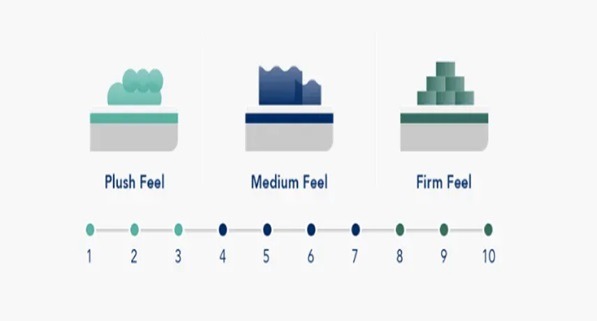Let’s face it; choosing the best mattress for your home is no mean task. Navigating several websites and physical stores is not fun at all. Sure, you want to pick the perfect mattress for your home because the wrong one can leave you with sleepless nights and achy mornings.
I’ve got news for you:
There’s no “PERFECT” mattress for all of us.
But wait…
In this definitive guide, you can find a path to follow. A path that leads you to find the ideal mattress. One that’s just right for your home.
Three Factors to Consider Before Picking a Mattress
Sure enough, there’s tons of information out there, but combing through web page after webpage can get you more confused than ever. Block out the noise, consider these three points, and you’ll have no problem picking the best mattress for your home:
- Bodyweight
- Sleeping position
- Material
Sleeping Position: In line with your body weight, your sleeping position also helps determine your ideal mattress’s firmness level. Mattress firmness levels are measured on a scale of 1 – 10 (with 1 being very soft and 10 being the firmest).
Of the three major sleeping positions, side sleepers tend to prefer the softest mattresses. Typically between 3-6 firmness level. Back sleepers do just fine with mattresses that have a 4-7 firmness depending on their weight. Stomach sleepers should go for the firmer mattresses to support their waists and avoid pains in their lower back. A 6-8 firmness level is perfect for stomach sleepers.
Body Weight: Generally, heavier sleepers (200+ lbs.) require firmer mattresses (7+ firmness) for extra support. In comparison, light (<150lbs.) to averagely-weighted (150 – 180lbs.) individuals will be adequately supported by soft to medium-firm mattresses.
Mattress Material: Broadly speaking, the four types of mattresses are:
- Memory foam
- Innerspring
- Latex foam
- Hybrid mattresses
Memory Foam
These are arguably the best mattresses out there. Sadly, some manufacturers produce low-quality memory foam and dent the reputation of them. Unbiased reviews from Sleepingnorth can help you pick good quality memory foams at the best prices.
Pros
- Memory foams are suitable for every sleeping position.
- Motion isolation feature, i.e., movement on one end isn’t felt on the other – just right for couples
- Pressure relief
- Proper spinal alignment.
Cons
- Memory foams are temperature sensitive, and that means your body may get hot during the night.
- The sinking motion of memory foam may not be enjoyed by some sleepers.
- Some memory foams give off a chemical smell
Summarily, memory foams are a growing group of mattresses that takes the body’s shape as you lay on them. They’re generally comfortable and come with various densities and thickness levels. If you don’t mind sleeping hot on some nights, the comfort they offer is worth the slightly higher price.
Innerspring
Popular, budget-friendly option. Innerspring (coil) mattresses have been around for the longest. They typically contain layers of metals coiled to serve as a protective base before adding some foam at the top for a soft feel.
Pros
- Generally durable
- Perfect for overweight sleepers as the metal springs offer the perfect support.
- Good air circulation around the mattress helps you sleep cooler.
Cons
- Lighter sleepers may find them too hard and wake up achy.
- Built as a single unit and so they are susceptible to motion.
- Largely unsuitable for side sleepers.
In a nutshell, innerspring mattresses are better suited for heavier sleepers and people with back pain. Also, they’re best for air circulation and can assure a cooler night’s sleep.
Latex Foam
Latex foams are generally the most expensive in the market, but manufacturers and users alike, agree that they’re worth the investment. They’re made from either natural or synthetic latex material. As you might have guessed, natural latex is of better quality and, consequently, more expensive.
Pros
- They’re bouncy and supportive.
- Offers as much support as memory foam, but firmer and more breathable, so you don’t sleep hot.
- No chemical smell
- Durable
- Suitable for all sleeping positions.
Cons
- May feel a little too firm for those who prefer softer mattresses
- Cheaper latex foams will turn lumpy
- They’re quite expensive
If you feel a firm, supportive, healthy, and breathable mattress is what you need, you should consider picking a latex foam for your home.
Hybrid Foams
Hybrid mattresses, as the name implies, are a combination of two or more mattress types. Typically, they contain the good ol’ springs from innerspring mattresses, a layer of regular comfort foam, and then crowned with memory or latex foam.
Pros
- Like innerspring mattresses, they’re very supportive
- Like memory and latex foams, they conform to the body’s shape and ensure proper spinal alignment
- They’re durable
- Breathable
- Like memory foams, they’re insensitive to motion.
Cons
- Hybrid mattresses are not suitable for people working on a tight budget.
In summary, hybrid mattresses are generally the best of all worlds. They combine the positives of each mattress type and shed off the negatives. Yet, be cautious of the constituent materials of particular hybrids before buying.
Takeaway
What works for your BFF may leave you sleepy and sore in the morning, and that’s why you should compare the features of each mattress before picking which is best for you.
Whichever mattress you pick, make sure you buy from a company that lets you try out a mattress before committing fully. You’ll probably spend 1/3 of the next ten years on that mattress, so make the most of it!
Any key takeaways or questions? Let’s interact in the comment section below!


